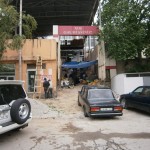
Home
My visit to Sri Lanka
Last August 2013 I visited Sri Lanka to teach researchers and fishery workers techniques to produce live feed for larval fish. Food fish such as Indian carps and many species of aquarium fishes are raised in Sri Lanka both as food for local consumers and ornamental fish for hobbyists. Exporting ornamental aquarium fish contributes revenues to Sri Lanka fish farmers especially in rural areas. By growing these live food organisms fish farmers can increase larval survival and production and improve the health of their fish.

Pouring water into concrete fish tank – Rambodagalla Ornamental Fish Culture Station

Moina – water flea – closeup
Algae in the Netherlands
Algae farming is being developed in a big way in the Netherlands. It is more productive than duckweed but is more difficult to harvest. Here are some pictures of large scale algae farming at the Algae Food and Fuel company in Lelystad, Netherlands.
My visit to Azerbaijan
Duckweed is not my only interest. Ever since I graduated from Auburn University’s International Center for Aquaculture I have been involved with or worked in aquaculture, especially fish and shrimp farming in the US and overseas. Last month I carried out an aquaculture assignment in Azerbaijan, a nation on the west coast of the Caspian Sea. During my visit I advised carp farmers in both Northern and Southern Azerbaijan on ways to improve production and develop hatcheries to produce carp fry and fingerlings. Here are some pictures from my visit:
My visit to Vietnam
I visited Vietnam in September 2012 where Matthew Carr of SNV World and I set up a small duckweed production facility near Hanoi, Vietnam. This production facility consisted of 2 small wading pools filled with drinking water and one scoop of biodigester slurry. We collected Lemna duckweed from a local village pond and used it to fertilize these 2 small pools. Four days later we returned to the village and harvested the duckweed. This harvested duckweed was used to feed pigs and chickens living on site.
Duckweed, A Plant to Watch
Duckweed refers to a family of floating aquatic plants with the scientific name Lemnaceae.The Lemnaceae are monocots ( like grasses and palms ) and are divided into 5 genera: Lemna, Spirodela, Wolffia, Landoltia andWolffiella. Of these 5 genera Spirodela is the largest and Wolffiella is the smallest.
Duckweed normally reproduces by budding (a form of a sexual reproduction)although it is capable of sexual reproduction as well. Duckweed may be the most promising plant for the twenty-first century for the following reasons:
Dynamics of Nitrogen Cycling in Lemna Wastewater Treatment Systems
Wastewater, formerly called sewage, must be treated before being released into the environment to prevent the spread of disease. Normally sewage is treated in special treatment plants that use bacteria, fungi and protozoa to decompose the organic matter present in wastewater into simpler, less toxic compounds. This decomposition takes place in both aerobic and anaerobic environments. The objective of all wastewater treatment plants is to decompose the organic matter contained in wastewater and to destroy any pathogens present, thereby preventing the spread of disease. Recycling wastewater nutrients or producing useful products from this waste material is not normally a priority in conventional wastewater treatment.
The Lemna Technologies of St. Paul, Minnesota has patented a new form of wastewater treatment. This technology combines conventional wastewater treatment lagoons with a pond covered by duckweed. This floating mat of duckweed effectively reduces the growth of phytoplankton (algae) and submerged aquatic plants by competing for nutrients dissolved in the wastewater and creating shade, which also prevents the growth of these plants. Furthermore this duckweed can be harvested and used as food for ducks and fish. This technology has the potential for recycling nutrients and producing useful products as well. Widespread use of this and similar technologies can kill 2 birds with one stone: treat wastewater and produce high protein feed materials. This technology should be particularly useful for developing countries. My interest in this technology was sparked by the abundance of life I found growing in and among the floating layer of duckweed. I was also excited by the potential duckweed has for wastewater treatment, an urgent concern all over the world.
FAUNA AND FLORA FOUND IN LEMNA TECHNOLOGY TREATMENT PLANTS
| Location | Date | Plants | Animals |
| Broussard | Sept. 8, 1995 | Floating Duckweed | Midge Larvae |
| Lemna obscura | (Chironomid larvae) | ||
| (dominant plant) | Oligochaetes | ||
| Wolffia globosa | Nais elinguis | ||
| (watermeal) | Ostracods | ||
| Limnobium spongia | |||
| (frogbit) | |||
| Sunset | March 13, 1997 | Wolffia columbiana | Oligochaetes |
| Lemna obscura | Aelosoma sp. | ||
| Scenedesmus sp. | Rotifers | ||
Microbes found in both Sunset and St. Martinville treatment ponds:
Protozoa – Paramecium, Stentor, Colpidium, and Spirostomum
Bacteria – Gram negative rods




































































